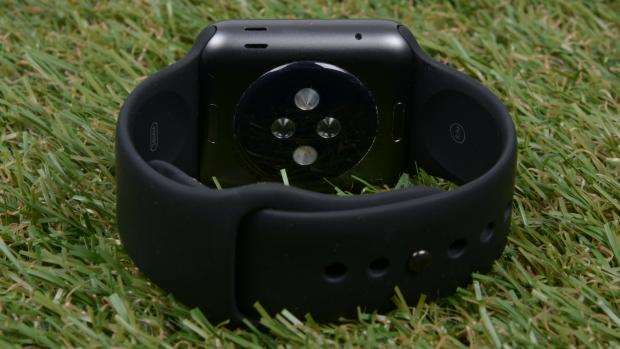Apple Watch apps
All apps are accessed through the homescreen, which is accessed by pressing the Digital Crown. The homescreen itself surprised me: I was expecting to have problems hitting the round icons for each app as you scroll around, but Apple has carefully optimised the touch targets so that, over a couple of weeks of use, I didn't hit a single wrong button. On a 38mm screen, that's pretty impressive.
The built-in apps on the Apple Watch are something of a mixed bag, and feel very much like “0.9” releases. Some, such as the Messages app, feel more complete, and have some nice Watch-specific features in them.
Others, such as Mail, feel almost like Apple didn't quite have enough time to work out what it wanted to do.
Most are fairly basic. Weather, for example, delivers pretty much the same information you get on an iPhone, but tailored to the smaller screen.
They usually carry over customised information from the iPhone, too: for example, Weather will display forecasts for all the locations you have set up as favourites on your phone.
Some of Apple's apps offer more features than others. For example, Messages is capable of using Siri for dictation so that you can initiate and reply to texts, and also lets you send little drawings, taps and even your heartbeat to other Apple Watch owners.
Email, on the other hand, can't do much at all – it's purely read-only. The Photos app is more basic still. You can view a set of your favourites, but you can't do anything with them.
If Apple's own apps are of varied quality, third-party apps are even more limited. Most app developers have had very little time with the device, and almost no experience of how users actually interact with a really small screen.
Already, some of the developers who dived into Apple Watch on day one are redesigning their applications to make them more effective.
However, developers can't currently do much about app performance. At present, very little app code runs natively on the Apple Watch. Effectively, most of the code runs on your iPhone, with the Watch displaying controls and results.
Applications that run on the Watch itself are coming “later in the year”, and you can bet June's Worldwide Developers Conference will reveal more details.
This has two implications. First, it means that, unless developers are very careful about the features they create, there'll be a lot of data flying back and forth between the iPhone and the Watch, all of which slows things down.
Tap on something and data will move from Watch to iPhone and back. Change the display and even more data will move around. This makes the experience sometimes sluggish.

Second, it means that if your Apple Watch isn't within range of the iPhone, many apps will either not work, or work with limited functionality. The Apple Watch isn't, at this point, an independent device.
However, there's a twist to this: the Apple Watch doesn't communicate with the iPhone only via Bluetooth, but also wi-fi. This means if your Watch is out of Bluetooth range of the iPhone, as long as you're on the same wi-fi network, everything will work as normal.
If you're in a home or office where you have a single logical network, this means you can leave your iPhone on the desk and it will happily communicate with the Watch anywhere around the building.
As well as launching from the homescreen, apps can also display what Apple calls “Glances”. Swipe down from the watch face and you'll see a list of your notifications. Swipe up from the bottom and you get into Glances, which are timely or contextually relevant collections of information from your favourite apps.
For example, a Glance for a podcast app might contain only the details of the current playing podcast, plus controls for skipping forward or back. A weather app might just display the weather data for your current location.
You swipe left and right while looking at Glances to get to the next or previous favourite Glance. Effectively, Glances are a fast way of getting to core information and features of an application. You're limited to 20 active Glances on your Apple Watch – given that you have to swipe between them, this is probably a sensible limit.
Next: Fitness






_(11).jpg&h=142&w=230&c=1&s=1)



.jpg&w=100&c=1&s=0)
_(8).jpg&w=100&c=1&s=0)









.jpg&q=95&h=298&w=480&c=1&s=1)


